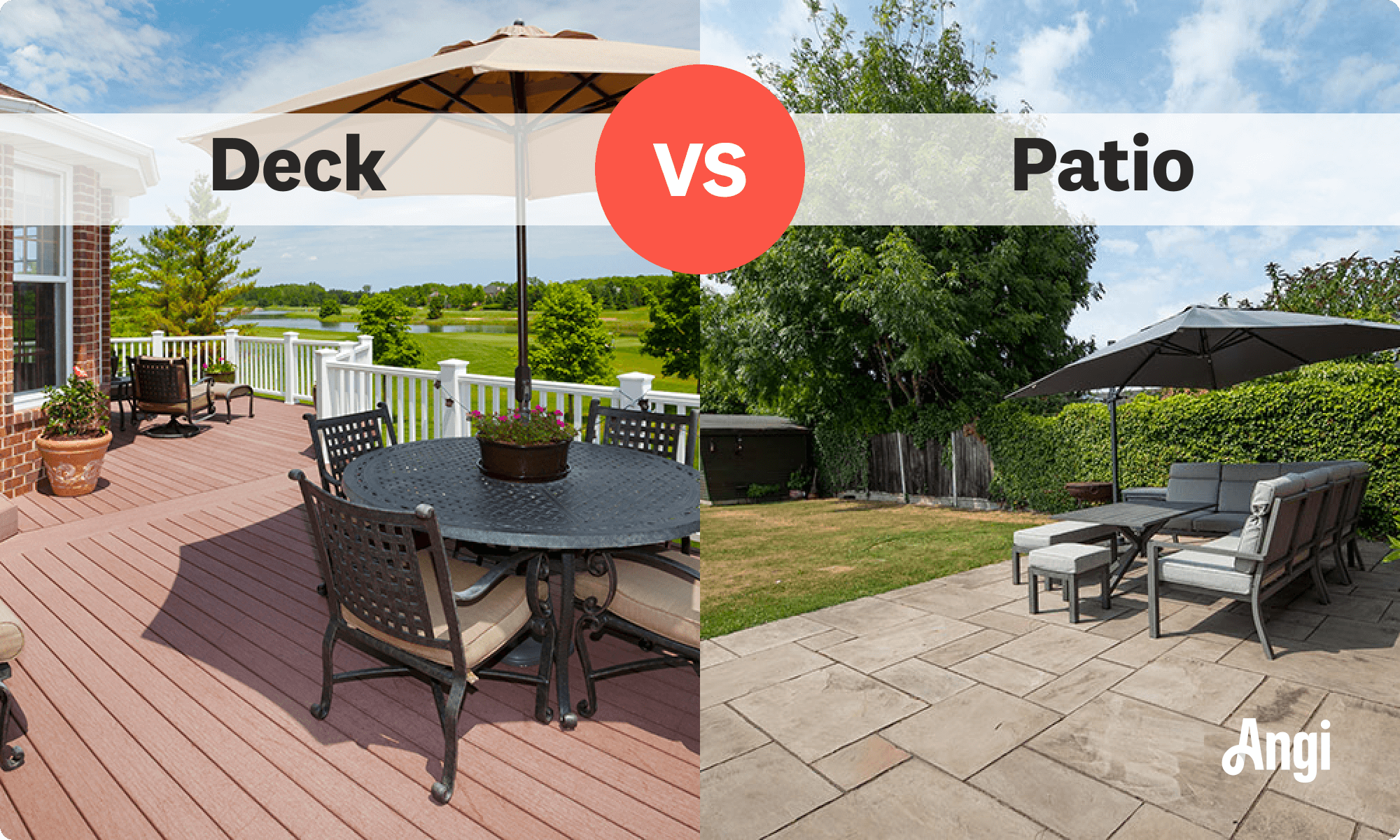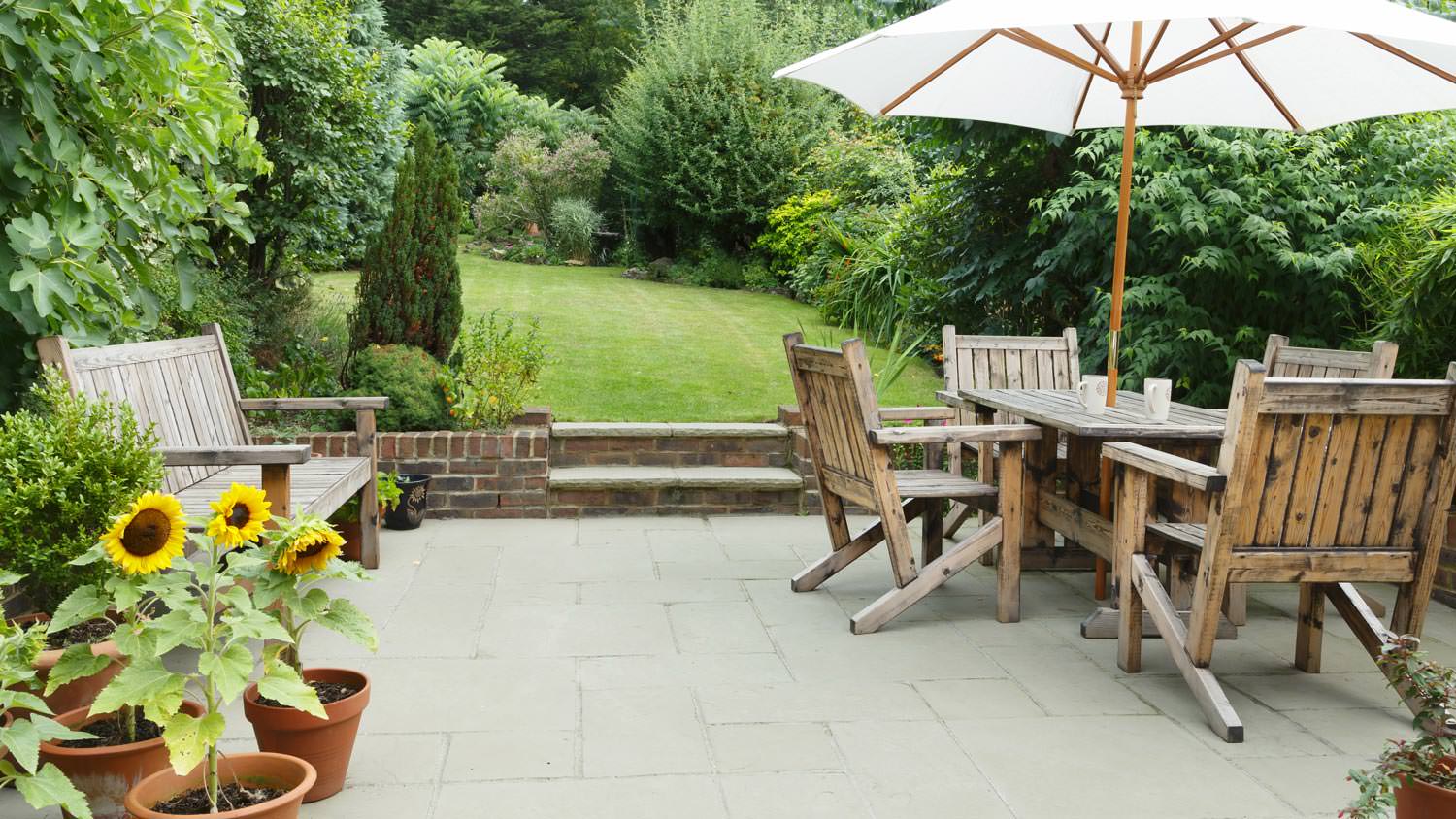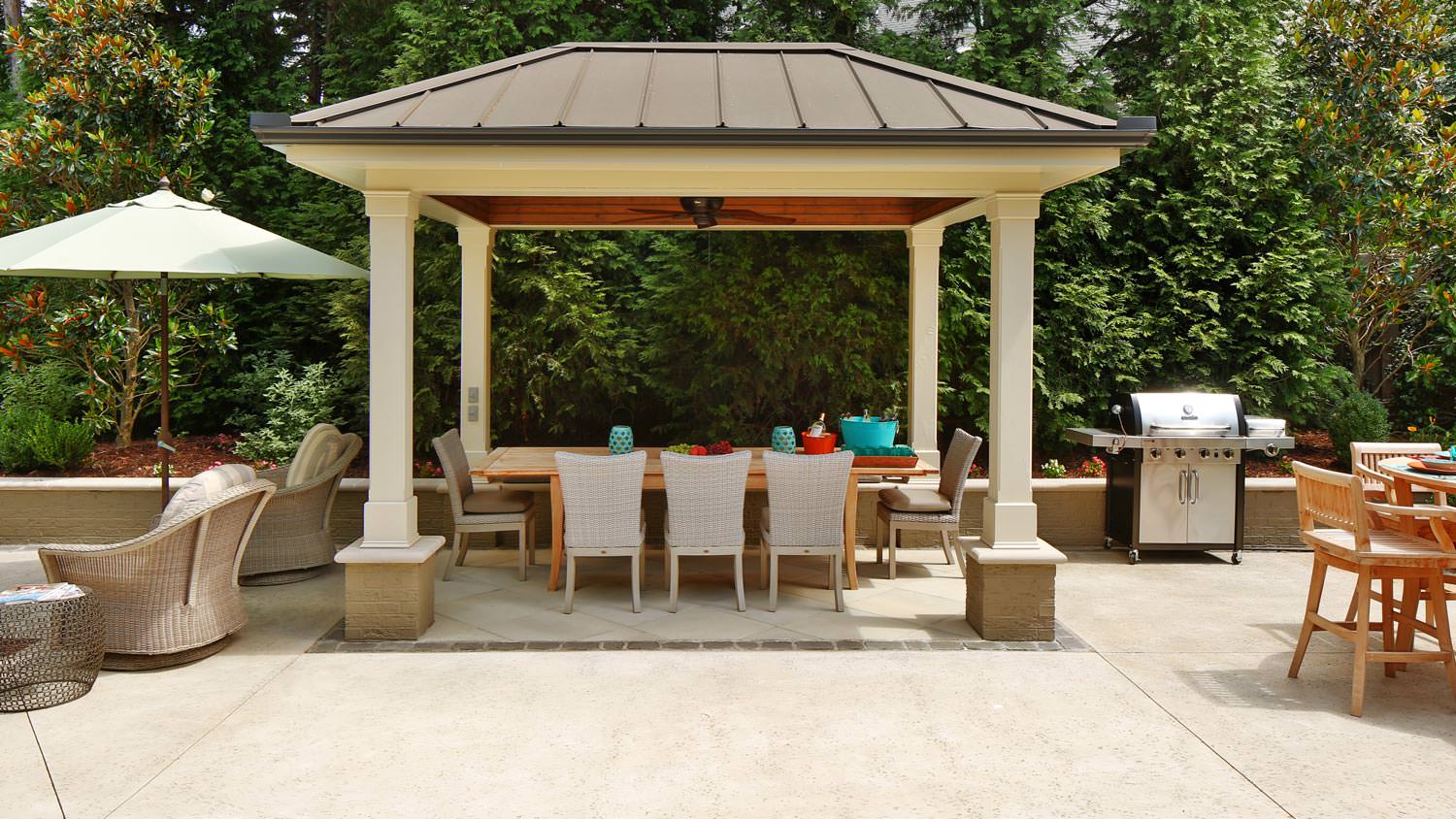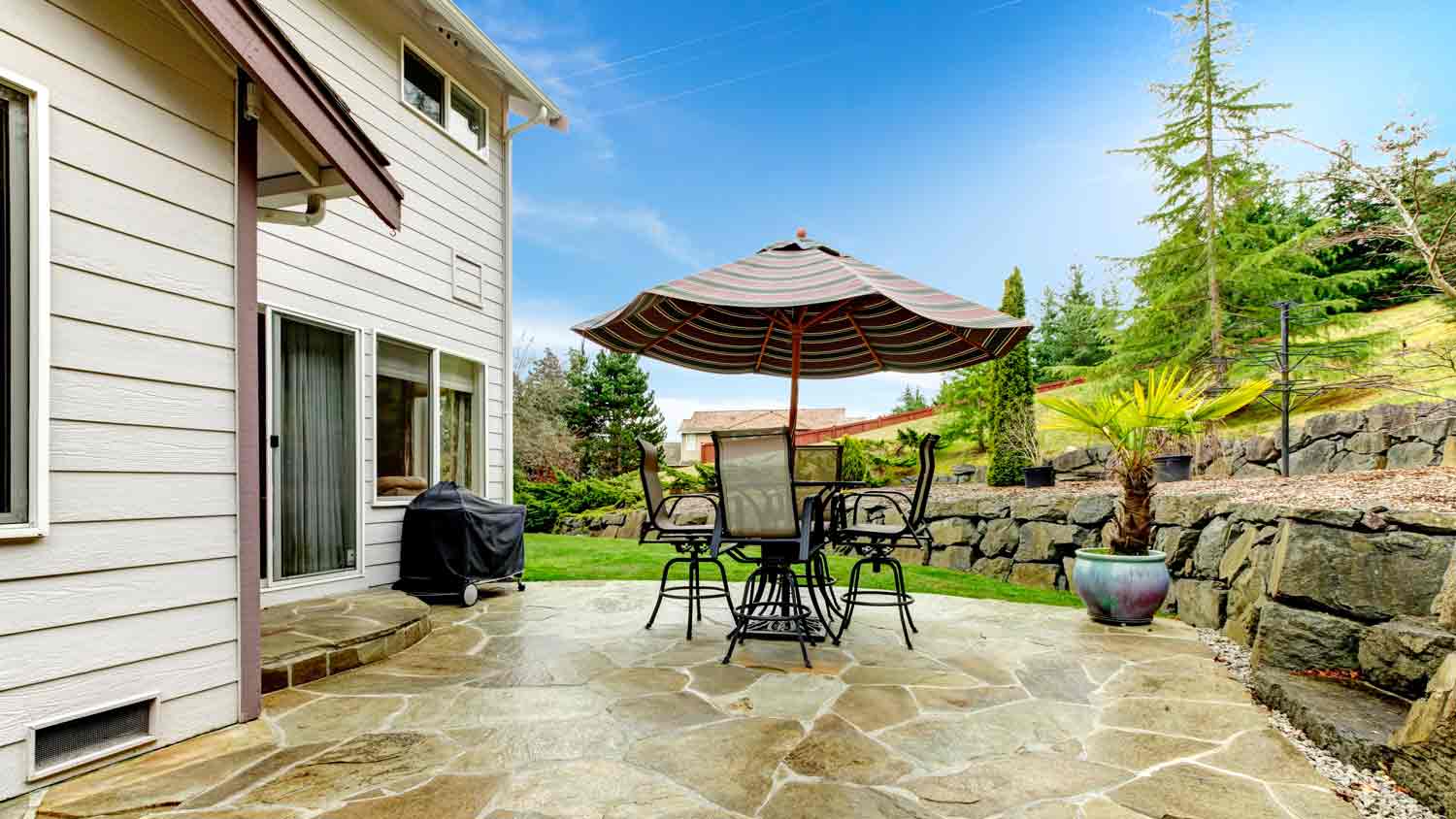
The average gazebo installation cost depends on the size and material. Keep reading to discover how much your gazebo may cost.
Decks and patios are both great ways to maximize your outdoor space


Decks are more expensive to build than patios.
Patios typically have a longer lifespan than decks, lasting upward of 50 years in many cases.
Patios are easier to install and maintain than decks.
Decks have a better ROI and often retain less heat than patios.
Adding a deck or a patio not only increases your home’s value, it also adds an entirely new living space that’s chock-full of potential. On top of being prime real estate for lounging, both structures can multitask as outdoor dining rooms, living rooms, outdoor kitchens, and nearly anything else you can dream up.
Decks and patios each have benefits and drawbacks, and deciding which is better for your home depends on your budget, personal preference, and your yard’s terrain. Let’s take a look at the difference between choosing a deck versus a patio for your outdoor space.

The main difference between decks and patios is elevation: Decks are built above ground level and supported by vertical joists, whereas patios are built flush with the ground. Both structures can be attached to the home or freestanding, and they can be made with a variety of materials and designs.

Decks are a great way to seamlessly expand your living space to the outdoors. There are many types of decks, but they’re most often made of wood. However, if you don’t want to deal with the maintenance of wood, you can choose from plastic, metal, or a combination of materials. Decks are typically built as an attachment on the back or side of a house and are ideal for grilling out and enjoying the weather.
| Pros | Cons |
|---|---|
| Increases home’s resale value | Expensive to build |
| Works well with uneven yard terrain | More maintenance requirements |
| Easily customizable | Shorter lifespan than patios |
Best for:
People with an uneven yard slope.
People worried about heat retention.
People looking for the largest possible ROI.
Increase home’s value: Decks increase the value of your home, meaning a deck has a great return on investment. They can boost your property’s value while also expanding your outdoor living space.
Ideal for uneven terrain: Decks are also a great choice for uneven yard terrain, since they are built over the ground rather than directly on top of it.
Customizable: Decks are easily customizable to match your design aesthetic or goals for the space. For example, you can design its shape and size to fit a hot tub, outdoor kitchen, or other entertaining spaces.
Expensive to build: Decks tend to be more expensive to build than patios, which means they may not be the best fit for homeowners on a budget. On average, building a deck costs $8,220.
More maintenance: Deck maintenance is essential and includes regular tasks like cleaning, sealing, and staining to keep it in good shape.
Shorter lifespan: Decks typically have a shorter lifespan than patios, especially wood decks.

Patios are an affordable, customizable option to transform your outdoor space. Concrete, brick, tile, and stone are the most common materials used in patio construction.
| Pros | Cons |
|---|---|
| More affordable to build than decks | Not fit for uneven yard terrain |
| Easy to maintain | Stains easily due to inclement weather |
| Increased privacy | Prone to cracking |
Best for:
People with a flat yard.
People who don’t have a lot of time for maintenance.
People who prefer a little extra privacy.
Affordable to build: Patios tend to be less expensive to build than decks, which makes them a great option for homeowners with a smaller budget. On average, a new patio costs between $2,050 and $6,050.
Easy to maintain: Patios are relatively easy to maintain with regular cleaning and debris removal. Prepare your patio for spring by cleaning the pavers and inspecting for any damage.
More privacy: Because patios are closer to the ground, they tend to be more private, especially if it’s inside a fenced-in yard.
Need flat ground: If you live on rocky or uneven terrain, a patio isn’t a great fit. Unlike decks that stand above the ground, patios lie right on top, so you may need to level your yard to construct a patio on it.
Stain easily: Patios often stain easily from inclement weather and require regular upkeep to ensure that they’re looking their best.
Prone to cracking: While patios tend to last longer than decks, they can crack or become damaged if installed improperly. Extreme temperatures can also cause patio cracking.
Patios tend to be more affordable than decks. The cost to build a deck is around $8,220 on average, while the cost to build a patio is around $4,000. Keep in mind that your project cost will depend on the size and specifics of your outdoor space.
Both decks and patios can add aesthetic appeal to your home. Since they’re attached to your home, decks are a natural extension of your living space and serve as a boundary between your home and the outdoors. On the other hand, patios can blur the distinction between inside and outside and blend in more with the surrounding scenery. Your personal preferences will determine whether a patio or deck is a better aesthetic fit for your needs.
You can customize decks and patios to suit your own personal style. You can choose from a wide variety of deck materials, stain shades, and paint colors. On the other hand, you can pick out patio pavers that suit your design aesthetic. In both cases, you can decorate your outdoor space with furniture and accessories of your choosing.
Patios tend to be more durable than decks—they typically have a longer lifespan and require minimal upkeep. Decks are more susceptible to weather damage, fading, and discoloration. Patios, meanwhile, can last for decades with minimal damage even when exposed to the elements.

Enterprising DIY homeowners can install decks and patios, but they often go more smoothly when completed by a local patio company or professional deck builder near you. Installing a patio typically doesn’t require a license, while a license is usually required when installing a deck.
Patios are more low-maintenance than decks. You need to periodically seal and stain wood decks in order to prolong their life and refresh their appearance. Patios only need regular cleaning and debris removal to keep them in tip-top shape.
Unlike decks, patios sit at ground level, so they aren’t susceptible to bending or caving in due to excess weight. Depending on the strength of their boards and internal framework, decks have a more limited weight capacity. Also, patios are constructed of stone, concrete, and other highly durable materials, while decks are usually made of wood and similar materials that aren’t as hardy.
Deck materials such as wood and composites naturally retain less heat than those used for patios, like stone, brick, or concrete. Decks built from natural wood typically stay the coolest. If you’re looking for a barefoot-friendly deck, choose light-colored woods and stains, as these will reflect more sunlight than their darker counterparts.
Since a deck is part of your home’s structure, it will typically require a building permit. Patios sit on the ground and are much simpler to construct, so they often do not. Either way, always check with your municipality to find out if you need a permit before beginning your build.
Building a deck is a complex, multi-day process that involves building footing and a supportive framework before laying the decking boards. This project takes much longer than building a patio, which generally only needs a weed barrier and some type of base, along with a second layer of support before the final layer. Concrete slab patios need a simple wooden frame to hold their shape as they’re poured. Patios can be completed in as little as a day, while decks can take up to a week or more.
Patios are prone to cracking due to extreme temperature shifts or improper installation. However, this doesn’t typically affect their safety or structural integrity (aside from creating tripping hazards). Deck repairs tend to be more serious and expensive to fix, plus their complex building process leaves far more room for wear and tear caused by improper installation.
Adding a deck can significantly increase the value of your home. While patios are also a valuable addition, they don’t raise your home’s value quite as much as decks do.
Whether you want to build a deck or a patio, there are several things to consider before you tackle this project. Although there is the possibility of saving money on labor costs, the scope of either project is time-consuming. Depending on the scope, it could take days or weeks to build. And unless you’re an experienced DIYer, these projects could be beyond your skill set.
Hiring a pro to build a deck or patio can reduce the time it takes to complete the project, streamline the handling of permits and regulations, and maintain the highest safety standards.
From average costs to expert advice, get all the answers you need to get your job done.

The average gazebo installation cost depends on the size and material. Keep reading to discover how much your gazebo may cost.

A worn-out awning won’t be able to block out UV rays or rain. Use this guide to explore awning fabric replacement costs by material type, awning size, and more.

Looking to build an outdoor entertainment space? Use this patio cost guide to get an idea of how much your exterior project will come out to.

Sealing a concrete patio can significantly extend its lifespan and enhance its appearance, preventing cracking, staining, and fading. Here are 5 reasons why you should seal concrete patios.

In the battle of PVC versus composite decking, which material comes out on top? Discover the benefits and drawbacks of each type in this guide.

Many homeowners wonder why their patio is sinking. We share the top five reasons and how to fix them.